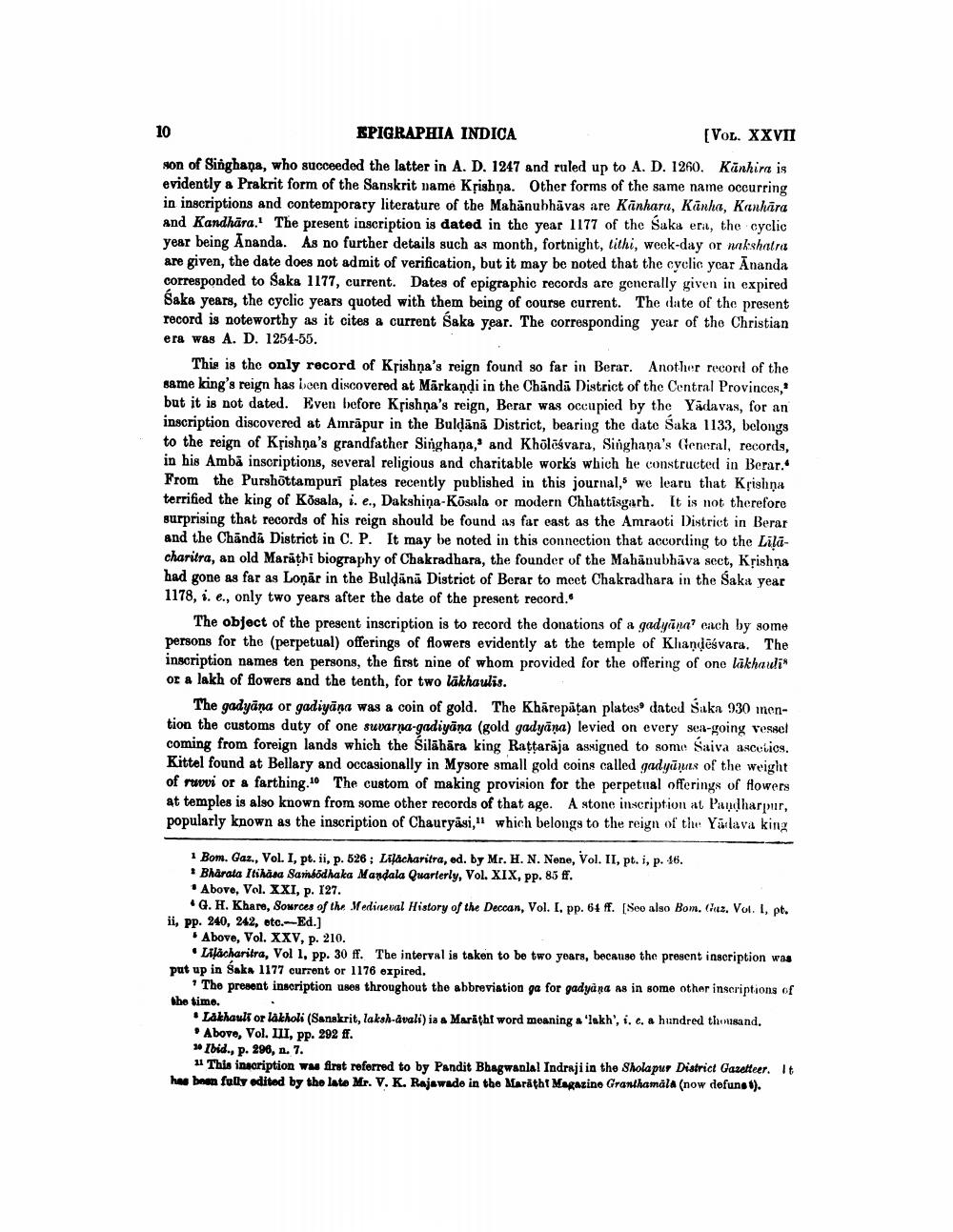________________
EPIGRAPHIA INDICA
(Vol. XXVII
son of Singhana, who succeeded the latter in A. D. 1247 and ruled up to A. D. 1260. Kanhira is evidently a Prakrit form of the Sanskrit Dame Krishna. Other forms of the same name occurring in inscriptions and contemporary literature of the Mahanubhavas are Kinharu, Kanha, Kanhara and Kandhära. The present inscription is dated in the year 1177 of the Saka erit, the cyclic year being Ananda. As no further details such as month, fortnight, lithi, week-day or nakshatra are given, the date does not admit of verification, but it may be noted that the cyclic year Ananda corresponded to Saka 1177, current. Dates of epigraphic records are generally given in expired Saka years, the cyclic years quoted with them being of course current. The date of the present record is noteworthy as it cites a current Saka year. The corresponding your of the Christian era was A. D. 1254-55.
This is the only record of Krishna's reign found so far in Berat. Another record of the same king's reign has been discovered at Märkandi in the Chandi District of the Central Provinces,' but it is not dated. Even before Krishna's reign, Berar was occupied by the Yadavas, for an inscription discovered at Amräpur in the Buldānā District, bearing the date Saka 1133, belongs to the reign of Krishna's grandfather Singhana, and Kholesvara, Singhana's General, records, in his Ambă inscriptions, several religious and charitable works which he constructed in Berar. From the Purshottampuri plates recently published in this journal,' we learu that Krishna terrified the king of Kösala, i.e., Dakshina-Kõsala or modern Chhattisgarh. It is not therefore surprising that records of his reign should be found as far east as the Amraoti District in Berar and the Chanda District in C. P. It may be noted in this connection that according to the Liļācharitra, an old Marathi biography of Chakradhara, the founder of the Mahanubhāva sect, Kộishna had gone as far as Lonär in the Buldani District of Berar to meet Chakradhara in the Saka year 1178, i. e., only two years after the date of the present record.
The object of the present inscription is to record the donations of a gadyanacach by some persons for the (perpetual) offerings of flowers evidently at the temple of Khandesvara. The inscription names ten persons, the first nine of whom provided for the offering of one likhawis of a lakh of flowers and the tenth, for two lakhaulis.
The gadyāna or gadiyāṇa was a coin of gold. The Khārepätan plates dated Saka 930 mention the customs duty of one suvarna-gadiyāna (gold gadyāna) levied on every sea-going vessel coming from foreign lands which the Silāhāra king Rattarāja assigned to some Saiva ascutics. Kittel found at Bellary and occasionally in Mysore small gold coins called gadyūnus of the weight of ruvi or a farthing 10 The custom of making provision for the perpetual offerings of flowers at temples is also known from some other records of that age. A stone inscription at Pandharpur, popularly known as the inscription of Chauryasi," which belongs to the reign of the Yülava king
1 Bom. Gaz., Vol. I, pt. ii, p. 526; Lisacharitra, ed. by Mr. H. N. Nene, Vol. II, pt. 1, p. 16. * Bharata Itihasa Sambódhaka Mandala Quarterly, Vol. XIX, pp. 85 ff. . Abovo, Vol. XXI, p. 127.
G. H. Khare, Sources of the Medineval History of the Deccan, Vol. I, pp. 61 ff. [Soo also Bom. (uz. Vol. I, pt. ii, pp. 240, 242, etc. Ed.]
. Above, Vol. XXV, p. 210.
• Lisacharitra, Vol 1, pp. 30 ff. The interval is taken to be two years, because the present inscription was put up in Saka 1177 current or 1176 oxpired.
The present inscription uses throughout the abbreviation ga for gadya na as in some other inscriptions of
Lakhauli or lakholi (Sanskrit, laksh-avali) is a Marathi word meaning a 'lakh', i.e. a hundred thousand. . Above, Vol. III, pp. 292 ff. ** Ibid., p. 290, n. 7.
1 This inscription was first referred to by Pandit Bhagwanlal Indraji in the Sholapur District Gazetteer. It has been fully edited by the late Mr. V. K. Rajawade in the Maratht Magazine Granthamala (now defunat).




